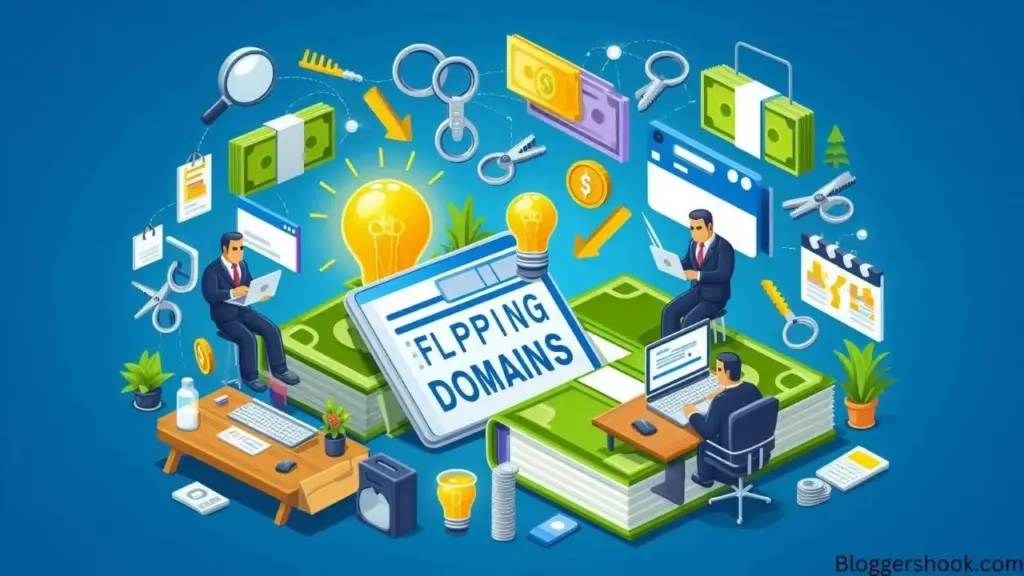The digital landscape offers a myriad of ways to generate income, with flipping domains standing out as a particularly intriguing and profitable venture. This business model, akin to real estate flipping but in the virtual world, involves buying domain names at a low price and selling them at a higher value.
Understanding the nuances of this practice can unveil opportunities for substantial financial gains. Let’s delve into the essentials of domain flipping, exploring its potential, strategies, and challenges.

Understanding Domain Flipping
Domain flipping is the practice of buying a domain name and then selling it for a profit. Domains are the digital real estate of the internet; they are addresses where websites live, and just like physical real estate, some locations (or names) are more valuable than others.
This business model leverages the fact that while some domain names may be bought cheaply, they can be sold for a significant profit if they hold potential value to businesses, investors, or individuals.
The Appeal of Domain Flipping
- Low Entry Barrier: Unlike traditional businesses, domain flipping requires minimal initial investment. Domains can be purchased for as little as $10 to $15, and the potential for return on investment can be significant.
- Scalability: This business model allows for easy scalability. An individual can manage multiple domains, increasing the chances of profitable sales without a proportional increase in effort or cost.
- Passive Income Potential: Domains can be parked, earning passive income through advertising while waiting for a buyer. This adds an additional revenue stream to the business model.
- High ROI: The return on investment can be substantial. Domains that meet specific criteria can sell for thousands, or even millions, of dollars. For instance, domain names like Cars.com or Voice.com have sold for millions.
Key Strategies for Successful Domain Flipping
- Research and Analysis: Before diving into domain flipping, extensive research is crucial. Understanding market trends, industry demands, and keyword popularity can guide decisions on which domains to purchase. Tools like Google Trends, Ahrefs, and SEMrush can provide insights into keyword demand and search volumes.
- Choosing the Right Domains: Domains that are short, memorable, and keyword-rich tend to have higher value. Here are some tips for choosing the right domains:
- Short and Sweet: Shorter domains are easier to remember and type, making them more valuable.
- Keyword Relevance: Domains that include popular keywords related to specific industries or niches can attract higher bids.
- Brandability: Domains that can be easily branded are in high demand. For instance, unique and catchy names can appeal to startups and businesses looking for a strong online presence.
- Avoid Trademarks: Stay clear of domains that could infringe on trademarks, as this can lead to legal complications.
- Purchasing Strategies
- Expired Domains: Many valuable domains expire daily. Platforms like ExpiredDomains.net can help identify expired domains with high traffic or SEO value.
- Auction Platforms: Websites like GoDaddy Auctions, NameJet, and Sedo offer domains up for auction. These platforms can be great places to find high-value domains.
- Backordering: This service allows you to attempt to purchase a domain the moment it becomes available. Services like NameJet and SnapNames offer back-ordering options.
- Valuation and Pricing: Accurate valuation of a domain is critical for successful flipping. Consider factors like length, keyword popularity, brandability, and historical sales data. Tools like Estibot, DomainIndex, and GoDaddy’s Domain Appraisal can provide estimated values. Pricing strategies can vary:
- Fixed Price: Setting a specific price based on your valuation.
- Make Offer: Allowing potential buyers to make offers, can lead to negotiation.
- Auction: Listing domains on auction sites can sometimes yield higher prices if multiple buyers are interested.
- Marketing Your Domains: Effective marketing can significantly increase the chances of selling your domains. Utilize domain marketplaces like Sedo, Flippa, and Afternic, which have a large audience of potential buyers. Additionally, using social media, email marketing, and even direct outreach to potential buyers in relevant industries can boost sales.
Challenges in Domain Flipping
Despite its potential, domain flipping is not without challenges. Understanding these can help in navigating the business more effectively:
- Market Volatility: Domain values can fluctuate based on trends, market demands, and technological advancements. Staying updated with market trends is crucial.
- Competition: The domain flipping market is highly competitive. Many experienced flippers and investors are always on the lookout for valuable domains.
- Legal Issues: Purchasing domains that infringe on trademarks or intellectual property can lead to legal complications. It’s essential to conduct thorough due diligence before purchasing domains.
- Selling Timeframe: Some domains may sell quickly, while others might take months or even years to find the right buyer. Patience and persistence are key.
Case Studies of Successful Domain Flips
To illustrate the potential of domain flipping, here are a few notable success stories:
- Voice.com: Sold for $30 million in 2019, this domain’s value was driven by the growing importance of voice technology.
- 360.com: Acquired by Qihoo 360, a Chinese internet security company, for $17 million in 2015. This purchase was driven by brand alignment and market positioning.
- CarInsurance.com: Sold for $49.7 million in 2010, demonstrating the high value of keyword-rich, industry-specific domains.
Tips for Aspiring Domain Flippers
- Continuous Learning: The digital landscape is always evolving. Stay informed about market trends, industry news, and new tools or platforms that can aid in domain flipping.
- Networking: Building relationships within the domain flipping community can provide valuable insights, advice, and opportunities. Participate in forums, attend conferences, and join relevant online groups.
- Diversify: Don’t put all your eggs in one basket. Diversify your domain portfolio across different industries and niches to spread risk.
- Legal Awareness: Always ensure your domain purchases do not infringe on trademarks or intellectual property rights to avoid legal issues.
Conclusion
Domain flipping presents a unique opportunity in the digital world, combining elements of investment, marketing, and entrepreneurship. With the right strategies and a keen understanding of market dynamics, it can be a highly lucrative business model.
As with any business, success in domain flipping requires dedication, continuous learning, and a willingness to adapt to changing trends.
Whether you’re looking to dip your toes into the world of online business or seeking a new investment avenue, domain flipping offers a promising path with the potential for significant financial rewards.


